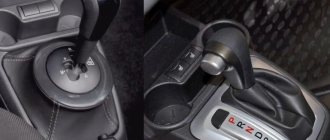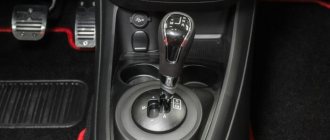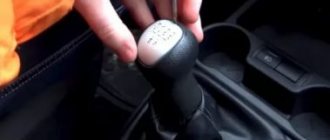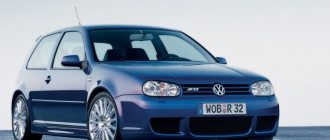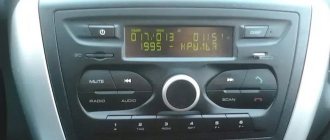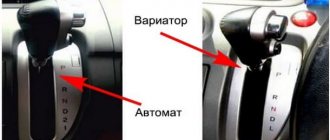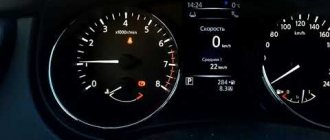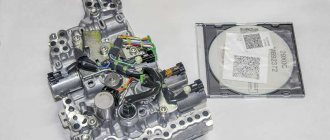The robotic gearbox is a joint development of AvtoVAZ together with the German company zf.
How does a “robot” work?
The robot is still the same 2180 gearbox with a cable drive with redesigned mounts, but in addition with an installed automatic shift mechanism, which was developed by the German company ZF. The automatic “actuator” mechanism depresses the clutch for you, puts the gear in gear, and releases the clutch.
The robot selector has the following positions:
N – neutral
R – reverse gear
M – manual switching mode
Vesta robot control diagram
Prices
In identical configurations, the robot requires an additional payment for the “handle” of 25,000 rubles, regardless of the engine - 1.6 or 1.8. But these are 2022 cars. The CVT on cars produced in 2022, if you count the difference with the base 1.6 engine with manual transmission, raises the price by 95 thousand. Quite a lot! Regarding the 1.8‑liter engine, the surcharge is less - 60 thousand rubles.
Reduced gear shift time: AMT 2.0 compared to the previous version, ms
| Percentage of pressing the accelerator pedal | From first to second | From second to third |
| 30 | 730 | 720 |
| 60 | 690 | 880 |
| 100 | 680 | 550 |
Robot on Vesta: reviews
Drivers online are furiously discussing Lada's innovation. Both experienced drivers and beginners who have previously driven only a manual transmission become participants in the debate. Reviews from owners of a Lada Vesta with a robot indicate that not everyone has an unambiguous perception of this new product. On the one hand, there are no those who are 100% satisfied with the AMT of the domestic manufacturer. On the other hand, is it worth being so critical of the first attempts to automate machine control?
Let's take a closer look. The main thing when buying a Lada Vesta with AMT is to clearly understand who such a car is intended for. First of all, this is a car for a quiet and comfortable ride around the city, and not for racing. Vesta with a robotic gearbox is ideal for city traffic jams. If you are tired of manual gear shifting, but foreign cars with an automatic transmission are not yet available to you, then the new Lada will be an excellent option.
Doesn't break anymore
I know firsthand how both options behave. I tested the CVT Vesta in the Caucasus and drove it in Moscow. And I’ve been living side by side with the robotic Vesta for 4.5 years now and have driven more than 90,000 km.
Life together with the robot did not work out right away. It is the driver who must adapt to it, and not vice versa! So, if you are looking closely at the “automated” Vesta of the first years of production (on the secondary market), keep in mind: you need to be a very calm driver with nerves of steel so that the box does not irritate you.
After about a year and a half in Tolyatti, the problem of the rapid death of the clutch was corrected. It turned out to be so gentle that even slow shifts did not help. On my car, the clutch kits lasted 20,000 and 18,000 km, and for some, the first signs of wear appeared after 5000–7000 km!
Now the third, reinforced clutch is coming to an end on the editorial car. You'll be lucky if it lasts 60,000 km (that is, up to 98,000 on the odometer). In general, you need to be prepared for quick repairs - and when buying a used Vesta, I would consider the original factory kit as a minus. Especially if it is an old model.
The Renault-Nissan 1.6 engine (113 hp) lacks a decorative cover. Let be! On a VAZ engine it is attached to flimsy pegs that are prone to getting lost. It does not protect from dirt outside and from engine noise - only decoration.
The Renault-Nissan 1.6 engine (113 hp) lacks a decorative cover. Let be! On a VAZ engine it is attached to flimsy pegs that are prone to getting lost. It does not protect from dirt outside and from engine noise - only decoration.
Interestingly, the clutches of the first and second versions signal wear differently. The old clutch begins to respond with shocks in traffic jams, and the car shakes in convulsions at the beginning of movement. The modernized one behaves intelligently, reminding of wear with exceptionally soft slipping, clearly visible in the timbre of the engine and tachometer readings. Therefore, now I will drive all the way, but I changed the previous sets preventively: I did not have the strength to endure their hysterics.
Review from the owner of Lada Vesta “Comfort” GFL12-51-070, 1.6 AMT engine
I left the salon. The robot manically switches up at the first opportunity, 60 on the fifth. Shifts are smooth, soft, no jerks or kicks. The pedal is long, on the Prior you have to press it a couple of centimeters and you fly, here you have to push far to keep it going.
You roll in auto mode on his favorite 1500, press the pedal, the robot is like - what? drive? where to go? A! he pressed the pedal! okay, okay, let's go, so be it. Drops a gear or two down, then normal acceleration with a sound familiar to the ear. It shifts exactly as you press. You stroke the pedal and the gears quickly click up. If you press harder, it turns up to 2000-2500. You press half the pedal - 3500 and you feel the usual pickup, there is no rush to switch. I didn’t press further for now.
The robot has a manual (manual) mode, it works something like this - Allows you to switch the way you want. Anywhere, anytime. What the robot does itself in this mode: in the cut-off it clicks up, when braking down, 5-4-3-2-1. Except for 1st gear, it does not shift up at any speed - in order to slip, drag trailers uphill, and so on. In manual mode, shifting is slightly faster. No worse, no better - for different tasks. You have to make some misbehavior - push the stick to M, push yourself twice, gas and off you go. I calmed down - put the handle in A and leaned back on the seat.
I used to say that the AMT switches like I do on a manual. No, it's not like that. She switches better than me. Smoother, faster, more accurate. Starts off instantly. A person can't do that. And if you let off the gas a little when switching, you don’t feel it at all, absolutely. In terms of switching time, AMT is at least the same as a simple automatic transmission, and maybe faster. The difference is that the automatic transmission shifts without a break in power, compressing one package and releasing the other, while the AMT needs to disengage the clutch, and you can feel it. The switching moment is comparable to a gust of wind on the highway. When you switch the manual transmission yourself, at that moment you are busy squeezing the clutch and shifting, but with AMT you are not doing anything, so the pause attracts attention. If you sit down like a sheep and press the gas to the floor, yes, it will make you nod, because the gear shift still remains smooth, no matter how much you press the pedal. In general, I think you can make the robot simply release the clutch during sharp acceleration, then you won’t have to nod, but there will be jerks. This should all be simple and understandable to those who drive a manual transmission. Fuel consumption on AMT is even lower than on manual transmission. In general, AMT is great. Especially considering the price tags for repairs and maintenance compared to a CVT or automatic transmission.
Brief impressions of the car.
Surprisingly, the Shumka is really not bad. Even the roof is noisy, the rain does not drum. I can't hear the engine. You can hear a certain hum from the wheels, not road noise, but just a hum. The murmur, like an open window, is very quiet. The doors close with a nice, quiet slam, as does the trunk. Perhaps I’ll add vibrations to the doors and leave it at that.
The chassis is still stiff after the Priora. Small irregularities are not felt, but the car follows the profile of the road exactly. But the energy intensity of the suspension is like that of a rally car. I don't know what needs to be done to break through it. More travel means fewer holes.
It stays straight like a tram. The wind, the potholes, the ruts - absolutely no problem. The steering wheel doesn't even move. The steering wheel is tight, of medium sharpness, with noticeable effort. It takes turns confidently, without rolls or drifts. Checkers - lightly, slightly moving the steering wheel.
The brakes are ideal in terms of pedal force and deceleration control. ABS and stabilization did not work, it was dry outside. The speed is felt weakly. You seem to be going about 60, you glance at the speedometer - it’s 100+. In general, it is very simple and easy to drive.
It's comfortable behind the wheel. The seat is not sporty, it is moderately soft, there is height adjustment and lumbar support. The steering wheel is adjustable for reach and height. The armrest in the middle is exactly as it should be. The interior is large, larger than in many C-class cars. Five of us will be comfortable.
The climate system is excellent. The air pressure is strong, the adjustment is smooth, the choice of modes is electronic, the air conditioning is not felt at all while driving.
The plastic in the cabin is very different. The steering wheel is soft and has different textures. The gear knob is normal. The panel and door trims are solid, just like the Polo. So far there is absolutely nothing squeaking. The trunk is lined with soft fleecy carpet.
The light is excellent. There is nothing more to say. I will add PTF. There are two LED lampshades in the cabin, the light is of medium brightness and diffused, but each works independently. You cannot turn on all the lights with one button.
There are not enough drawers and shelves. There is only a huge glove compartment, a small shelf and two cup holders on the beard and a small drawer in the armrest. And the door handles are made like a mini shelf for small items. All. But the pockets in the front doors are a glove keeper's dream, they are gigantic. There are no pockets at the back.
The music is the most ordinary. The staff is just a staff, nothing special, like everyone else. Radio, USB flash drive, SD flash drive, bluetooth, AUX. Large buttons, control from the steering wheel. Out of habit, I point at the phone and forget about the steering wheel. There is an ACC mode.
Disadvantages - unpleasant ESP buttons, tight and with a short stroke, like on a grant. The climate control knobs rotate without effort and have some play. The visors, when folded toward the glass, dangle on the bumps. Dim light in the trunk.
A bit of new impressions. The Vesta suspension was fine-tuned in Spain at the training ground. So, on roads close to those in Spain, the car drives wonderfully. But as soon as you drive off the road onto broken asphalt, or onto a road with artificial bumps, it starts to shake violently. The suspension regularly follows the profile of the road. Now I’m ready to kill for sun loungers. Yes, even when driving on normal roads of varying quality, you feel the difference very clearly. And this is on small 15 wheels with a high profile. Priora didn’t give a damn that there was soil, asphalt, crushed stone, milling cutter under the wheels, as long as all the irregularities were within 18 cm of clearance, always soft and comfortable. This is the price of good handling
Vesta is a good car, I can say that now for sure. Good quality, comfortable, beautiful and big. It’s not ideal, but it evokes positive emotions and makes me want to drive it.
Yesterday I went for a free inspection to the dealer. Before this, I returned the standard mafon back just in case. They examined it, extended it, everything was as it should be, they said that everything was fire. Only the front wheels and a couple of nuts on the front were stretched. We were allowed into the repair zone without any problems. The removed caps were pulled back with zip ties - that’s nice. The mileage is now about 1600 km, the average consumption according to the BC is 9.3 liters.
I noticed that there are no caps on the front hubs, it needs to be farmed. The most vulnerable point on the body is the rear tow hook, it’s at the very bottom of the rear overhang, I’ve already gotten caught somewhere. Additional protection without holes at all. But the face turns out to be completely smooth, from the front bumper to the floor, which is good for winter.
I really like the car. There are a couple of points on Shumka that I will do, but these are minor things. Parking sensors are a thing for the lazy, but very convenient. I use cruise even in the city sometimes, at 77 km/h. The light is excellent. The A-pillars are wide, the hood is high, and sometimes I look for curbs in yards through the side windows. The glazing has an interesting effect - it is positioned at such an angle that from the outside it seems as if it has been tinted with thirty, there is no feeling of an aquarium. I washed the interior - the plastic is somehow slippery, the dirt is wiped off very easily in one motion without streaks. The seats are a strong magnet for hair and cat fur.
And the motor opened. After 3000 it drags the 1.3-ton car very cheerfully with a characteristic rumbling sound. Not the same as on the Prior, there it was less pronounced and with some kind of whistling. Although the 129 is more powerful from the bottom than the simple 126, its combat character remains the same. This makes me happy.
The variable intake switch is audible in the cabin and works a little differently than I thought it would. It is triggered not by revolutions, like phasers, but by the load on the motor. If you drive calmly, it is closed even at 4000. As soon as you press the pedal, a growl appears from under the hood, while traction improves. At 1500 it is even very loud, at 3000 it merges with the engine. In hot weather with Conder, the damper opens almost every acceleration.
AMT, in principle, has already adapted to my driving style and almost always switches on time. But it was not possible to discourage his manner of switching up at the first opportunity to save money. A couple of times there was a freezing of 1st gear during repeated sharp stomping from a standstill half a meter and braking in the city crowd. It has a mode for hauling trailers and climbing uphill, when under load it holds first gear and does not shift, apparently it thought that I was accelerating somewhere off-road. It can be treated by switching to M and back to A. It also coolly re-throttles itself, switching down when pressing hard on the gas.
To go or guarantee?
How to buy a car with adequate AMT? There are two options. The obvious one is to choose version 1.8. An alternative is to go to unofficials for new firmware. Craftsmen with a laptop can reflash any Granta, Vesta or Xray for 2000–3000 rubles and 20–30 minutes. The engine and year of manufacture do not matter. We did this too. Moreover, they downloaded more advanced software to us than the factory one. It also has a sports mode, in which the engine is more willing to rev to the top, and the gearbox feels even a little more agile.
Advantages of "Robot"
The advantage of a robot over mechanics: convenience, because Only one leg is occupied, both hands are on the steering wheel.
The advantage of a robot over an automatic: it is more economical (What is the fuel consumption?) than a conventional automatic, you can tow a car, slipping is allowed on the roads, the dynamics of the “mechanics” are preserved.
It is also worth noting that the robot has protection against “crooked hands”. In other words, randomly switching the robot selector while driving will not cause any damage. In addition, Priora, like Vesta on a robot, can be started from a pusher, you can drag a trailer, tow a car - you just need to switch to mechanical mode.
The first robots were installed on the Lada Priora with a 1.6 liter engine producing 98 hp. But the robot has already been reprogrammed for the new 127 engine, paired with which Vesta will be produced.
If savings are important, then your option is 1.6 with a robot.
Robot or CVT: choose the Lada Vesta that suits youWhich is better to choose manual or AMT?
The choice between a manual transmission and AMT should be made with a cool head, having calculated all the pros and cons in advance. On the Internet you can find many good reviews about the mechanics or robot of the Lada Vesta. But most drivers opt for an automated manual transmission. It is much more convenient and economical to use. But lovers of classics and conservatives still prefer the usual mechanics. You can only understand whether a car with AMT is suitable for you or not by trying it in action.
Features of operation
In accordance with the reviews, a list of custom features of the AMT transmission has been compiled:
- Unlike an automatic transmission, AMT does not have such a mode as “parking” or “P”. Therefore, reviews recommend leaving the AMT in gear when parked, turning off the engine in mode “A” or “R”. And with the engine not running, move the lever to “N” mode, but even in this mode the gear will be engaged. When the ignition is turned on, the speed will automatically turn off. Therefore, you need to remember this feature of the AMT, and to prevent the car from rolling, in this case the car is fixed with the brake pedal. Moreover, the car will not start without pressing the brake pedal. Which some car enthusiasts point out as a disadvantage, and others as an advantage that increases the safety of starting the engine when the speed is accidentally turned on, for example, as with a manual transmission;
- Unlike simple mechanics and an automatic transmission, AMT will not move the car at idle speed, that is, driving at idle speed is impossible. To start moving smoothly, you need to add engine speed by pressing the gas. What is indicated as a disadvantage in reviews from residents of megacities, who often find themselves stuck in traffic jams. Therefore, for those who periodically encounter traffic jams, during short stops it is recommended to switch the lever to the “N” mode, because after a minute of parking with the brake pedal not pressed, the switch will disconnect the clutch by pressing the release lever, which can subsequently negatively affect the release bearing . However, some reviews provide examples of the opposite opinion, that this has absolutely no effect on the condition of the release bearing;
- There are many opinions in the reviews about braking using AMT. When braking the engine by resetting its speed, the AMT reacts quite sensitively in higher gears by switching to lower ones, but many recommend doing this in combination with the brake pedal depressed. Regarding smooth braking with the help of brakes, AMT “helps” to brake by switching lower gears. But during heavy braking, the AMT completely disengages the clutch. But in some reviews there are stories about some “sagging” of the brake pedal in these cases.
- after sharp braking, the clutch remains open until the engine speed is increased by the gas pedal;
- When you apply emergency braking using the brake pedal, the Brake Assist System (BAS) is activated and the clutch is instantly released.
New technologies in domestic production
Buyers choosing a new car look thoughtfully at the new AMT from Lada. What is it, what is its operating principle? In fact, this is a regular manual transmission, only it does not have a clutch pedal. Instead of three levers, you only get two - gas and brake. The compact gearbox has off, on and shift modes, which replace the familiar pedal.
Reviews of the Lada Vesta robot show that not everyone liked the manufacturer’s innovations. The automated gearbox is developed on the basis of the manual transmission of VAZ cars. The control system uses the latest ZF developments, which help to change gears faster. In terms of quality, the new AMT is clearly better than the old technologies on the Lada Kalina, but at the same time inferior to European analogues (BMW, Ford, etc.). What positions are there on the shift lever in the new Lada Vesta?
- Auto mode – allows you not to think about changing gears at all.
- Neutral position is acceptable when the car is parked.
- Reverse – in this position, as you might guess, the car will go backwards.
- Manual shift - allows you to change gears yourself if you want to overtake someone or save fuel. If you want to downshift, then you don’t have to touch the lever at all - the Lada itself will do everything for you if you take your foot off the gas pedal.
